|
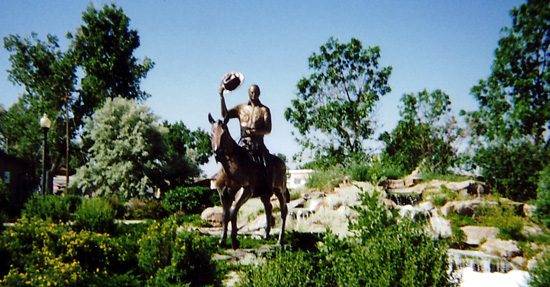
Entrance to Wyoming State Fair, Douglas,
2005. Photo by Geoff Dobson
According to state legislator Doug Samuelson, the statue is of rancher and state representative James C. Hageman (1930-2006). Hageman represented the
third generation of a family that supported agriculture in Wyoming beginning with his
grandfather, James C. Shaw (1852-1943). Shaw, in the words William Chapin Deming, was a Texas
cowboy "who made good in Wyoming."
Shaw arrived in Wyoming from Texas in 1879 and worked in the 1879 Roundup.
After six weeks he was let go on Christmas Day. Until spring came and he could obtain work, Shaw survived on
wild game. He served as foundup foreman from 1884 to 1897. He became range manager for the Teschemacher and DeBillier Cattle company before Teschmacher and
DeBillier fled to France following the Johnson County War. Shaw starting small formed his own
cattle company and later served as treasurer for the State Fair, state representative, and as president of the
Wyoming Stock Growers Association.
Nothwithstanding Col. Kimball's pessimism referenced on the preceding page, Douglas became the
permanent home of the Wyoming State Fair and Rodeo. A Territorial Fair had been
held in Cheyenne in the 1880's and an Industrial Exhibition held in Sheridan in 1903 and Casper in 1904.
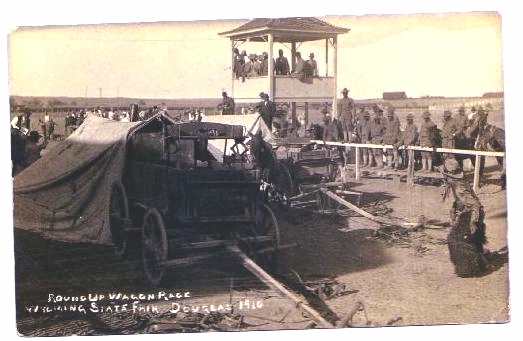
Roundup Wagon Race, Wyoming State Fair, 1910. Note Buffalo soldiers in background.
In the Roundup Wagon race held on the first day of the Fair, Tom Bell's "Car Link" and James C. Shaw's "Q" outfits competed. The "Car Link" wagon was fastest around the
track, but the race also included setting up the mess tent and lighting the stove. The "Q" wagpm
got its stove lit first and thus won the contest. The Q was located near Orin in Converse County and the Car Link was located
at Node to the east of Lusk.
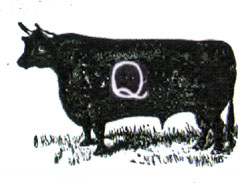
J. C. Shaw
Orin Junction, Wyo.
Cattle left side and Shoulder
Range, Antelope and Walker |
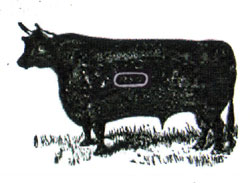
Thomas Bell
P. O. Lusk, Wyo.
Cattle branded car link on any
part of animal.
Usual range,
Running Water Divide |
Another race off of the rannge was the "rep race." In the rep race entrants started off in a bedroll on the ground.
When the signal was given, cowboys had to get up, put on their chaps; roll up the bedroll;
pack, saddle and bridle their horse; and then do a lap around the track.
The first buildings at the State Fair cost $10,000 and garnered an attendance
of 2,500. The Fair has been held continually ever since with the
exception of two years during the Depression, one year when cancelled due to a
polio epidemic, and the War years.
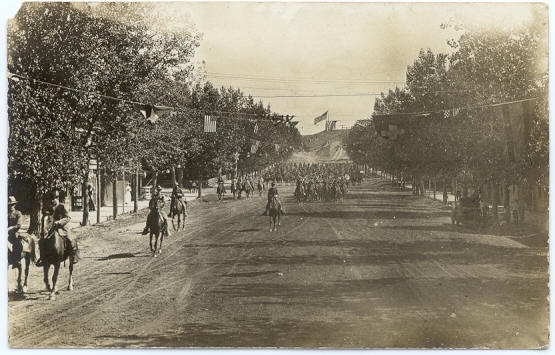
9th Cavalry, Buffalo soldiers, Wyoming State Fair, 1910.
The 9th Cavalry participated in the Roman Races on both the first and second day of the 1910 Fair, gave examples of close order drill,
and participated in the
parade. The morning of the last day of the fair featured a baseball game between Douglas and Sunrise.
A featured appearance at the fair was
anticipated to be Goldie St. Clair, Champion woman bronco rider of the World. The following year, 1911,
the 9th Cavalry took on Cheyenne's professional ball team, the Cheyenne Inidans.
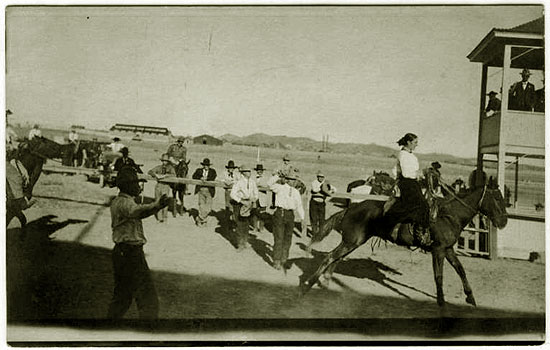
Goldie St. Clair, Wyoming State Fair, 1910.
Unfortunately as Mrs. St. Clair was giving an exhibition, her horse ran into a fence and fell, pinning Mrs. St.
Clair beneath the horse. Her injuries, however, were minor.
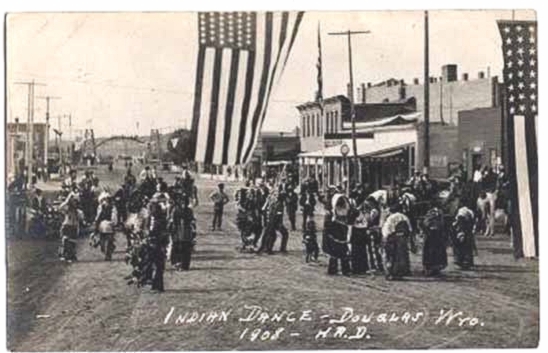
Indian Dance, Wyoming State Fair, 1908
Besides the roundup wagon races, Roman Races, and relay races were conducted. Perhaps the most
anticipated event of the 1910 fair was the appearance of the Irwin Bros. horse Teddy Roosevelt in
the bronco contest.
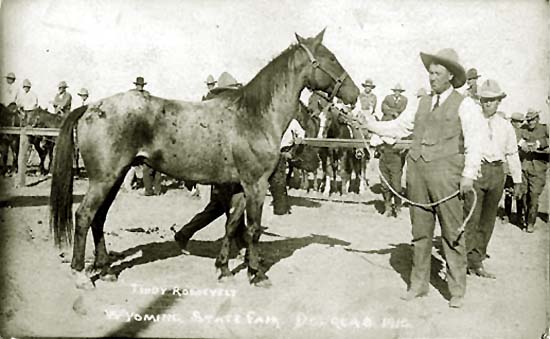
Teddy Roosevelt and C. B. Irwin, Wyoming State Fair, 1910.
On Thursday, Gustaf E. "Gus" Nylen of Converse County attempted to ride Teddy Roosevelt. He was thrown. In rodeo
circles, however, Nylen is famous as the cowboy who was thrown by Teddy Roosevelt at the
1910 Frontier Day rodeo. The photo of Nylen in mid-air made Ralph Doubleday famous. See photo
Frontier Days.
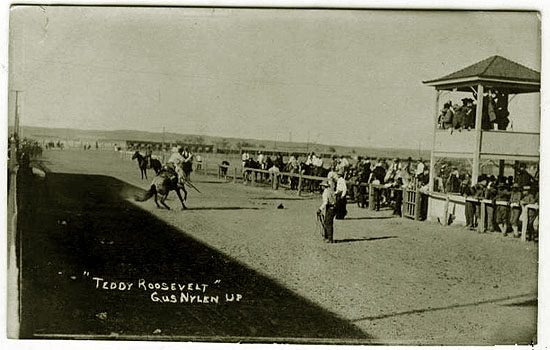
Gus Nylen on Teddy Roosevelt "going up," Wyoming State Fair, 1910.
The next day, however,
Carl Hildebrand rode Teddy Roosevelt, but "pulled leather" and was, thus, disqualifed. To "pull
leather" is to grab the saddle horn or the saddle to prevent from being thrown. In any event, however, Hildebrand stuck to the horse and, according to Bill Barlow's Budget, won
money on side bets. Hildebrand also come in third in Thursday's men's relay race. One of the more
interesting events that Hildebrand particiipated in was three years later at the Industrial Exposition in Casper.
There he won a race in which there were stops at various beer "stations." The wining prize was $20.00. It was kind of like a
modern "5 K" "beer run" where the runners race from saloon to saloon, only it was on horse back.
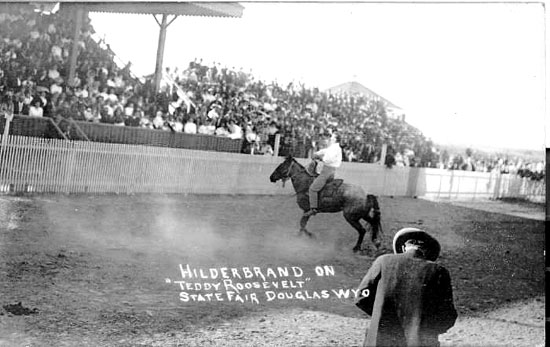
Carl Hildebrand on Teddy Roosevelt, Wyoming State Fair, 1910.
Next page: State Fair continued.
|